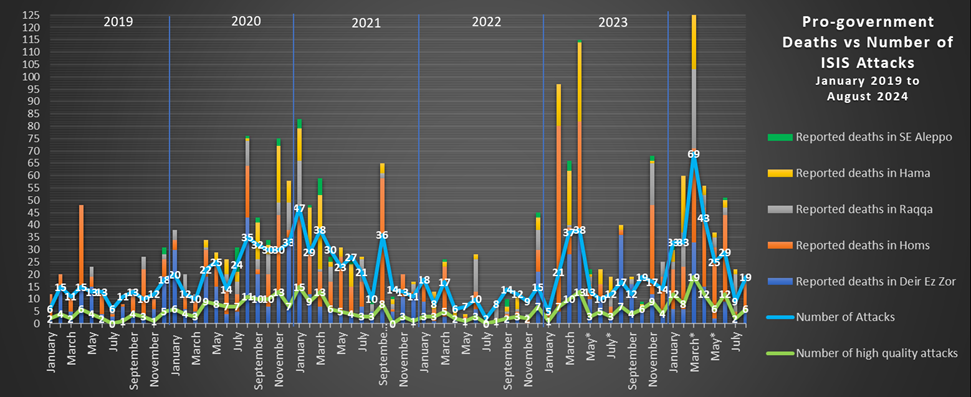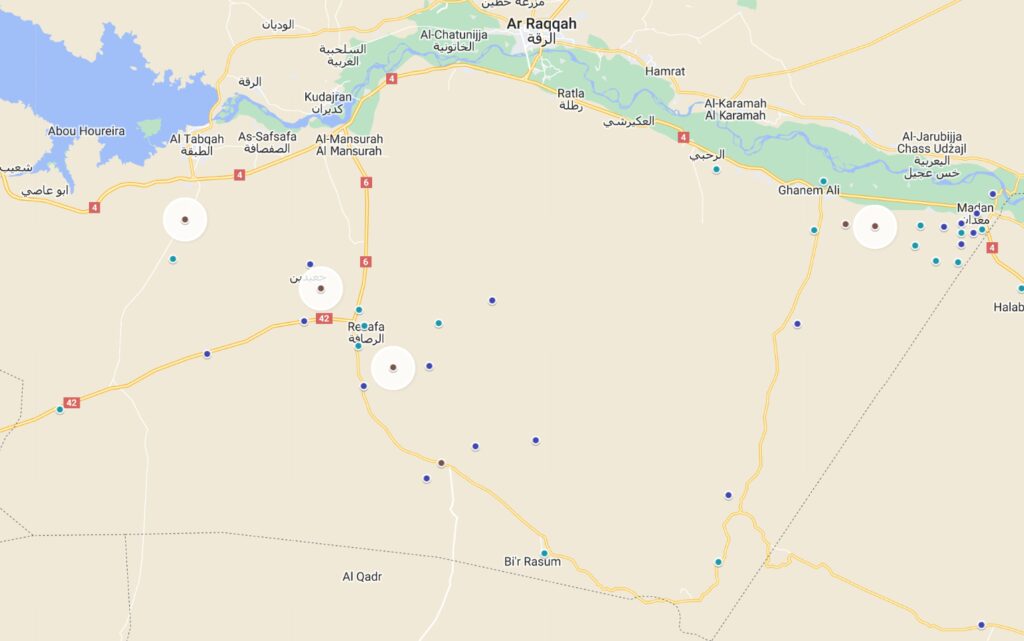ISIS carried out at least 19 confirmed attacks in August in the Homs, Raqqa, and Deir Ez Zor governorates. These attacks killed at least 12 pro-Assad regime soldiers and seven civilians and wounded at least 25 others. There were also six high quality* attacks carried out during the month. The level of ISIS violence therefore increased throughout August, back to a more standard level following a much quieter period in July, but still remained below the high level of violence experienced during the earlier months of 2024. Additionally, civilians were heavily targeted in August, with five documented attacks against shepherds in Homs, Deir Ez Zor, and Raqqa.
ISIS attacks in August were more frequent, deadly, and sophisticated than those in July. ISIS cells appear to have relocated following large regime operations and deployments this summer, and are no longer heavily targeting regime forces in the Palmyra and Sukhnah axes. Still, militants were able to capture some remote regime positions along the Iraqi border – a critical area for human and weapons smuggling – as well as once again carrying out urban assassination operations in Deir Ez Zor, which did not occur in July. Throughout the month, the Russian Air Force continued its high-tempo aerial campaign against suspected ISIS positions in the desert.

*Indicates attacks in Damascus City claimed by ISIS. Additional IED attacks occurred in Homs City in June 2023 and Damascus in March 2024 and May 2024 that went unclaimed but were suspected to be conducted by ISIS.

Confirmed ISIS attacks increased significantly in Homs (8) and Deir Ez Zor (7), increased slightly in Raqqa (4) and were not documented in Hama (0) or Aleppo (0).
Deir Ez Zor and Raqqa
ISIS expanded its low-level insurgency within the urban belt of Deir Ez Zor in January, when it conducted three assassinations of local security forces. Sleeper cells continued this trend in February, carrying out two assassinations of local pro-regime fighters inside Mayadin city, and again in March and April, with four and three urban attacks respectively. In May, regime security forces captured a small four-man ISIS cell inside Mayadin. According to local journalist Zain al-Abidin, three of the detained men were serving in the pro-regime National Defense Forces (NDF) and their leader had entered Mayadin from northeast Syria during the regime’s 2022 reconciliation initiative – a security risk this author had highlighted at the time. There were no recorded attacks in Mayadin in June, however, there was an improvised explosive device (IED) attack inside Deir Ez Zor City and a small arms attack inside Shamitiyah. While there were no recorded urban attacks in Deir Ez Zor in July, in August suspected ISIS militants assassinated a local pro-regime fighter in Mayadin and a military intelligence member in Deir Ez Zor city.
On August 6, four soldiers of the Russian-backed 5th Corps were killed in an attack on their position near Shoula. According to journalist Zain al-Abidin, the men’s unit did not realize the soldiers had been killed until two days later. On August 14, two shepherds were attacked outside Baqras Fawqani and their sheep stolen. Local militia and tribesmen mobilized that night and went out into the desert but were unable to find the attackers. On August 16, suspected ISIS militants attacked another group of shepherds nearby, stealing 60 sheep.
On August 22, suspected ISIS militants conducted two urban assassinations. In Mayadin city, men on a motorbike shot to death a local pro-regime fighter outside his house. In Deir Ez Zor’s Qussour neighborhood, gunmen killed a member of the regime’s military intelligence unit. On August 26, ISIS members killed two more regime soldiers in an attack on their position near Shoula. On August 30, four members of the Iran-backed Liwa al-Baqir militia were wounded by a mine near Duwair.
In Raqqa, ISIS activity in May dropped back down to more typical levels following two months of heightened activity. Since then, the group has maintained a low-level but robust insurgency focused in the desert between Resafa and Jabal Bishri. This trend continued in July and August. On August 5, a member of the regime’s 17th Division was killed by a mine or IED in the countryside just north of Resafa. On August 9, militants attacked a 4th Division position southeast of Resafa, wounding two soldiers. On August 16, three special forces soldiers were injured in an attack south of Tabqa Airport. This was the first attack near Tabqa airport since the spring of 2024. On August 28, suspected ISIS militants killed two shepherds and hundreds of sheep in an attack near the town of Ma’adan, an area where civilians have been routinely targeted this year.


Map of locatable ISIS attacks (highlighted) in Dier Ez Zor (top) and Raqqa (bottom) in August 2024 alongside all other attacks in 2024.
Homs
ISIS activity in eastern Homs decreased in December 2023, but remained focused around the Doubayat Oil Field, which the group had temporarily captured in November. January 2024 likewise saw most ISIS activity concentrated in this area, though the group also expanded operations west into the desert just south of Palmyra and Arak. In February, ISIS largely abandoned the southern Palmyra front, likely because of pro-regime ground and air operations, and shifted its focus to the Taybeh sector north of Sukhnah and the Jubb Jarah mountains north of Palmyra. This focus continued into March, with activity remaining concentrated in the Sukhnah-Taybeh-Kawm axis in both April and May. However, security forces continued to largely stand their ground and June saw ISIS once again shift its attacks to the Jubb Jarah and southern Wadi Doubayat-Palmyra region, seemingly abandoning the Taybeh-Kawm front. The deployment of significant numbers of Russian-backed 25th Division fighters in early June and those subsequent battles appear to have resulted in ISIS largely abandoning all eastern Homs fronts in July. In August, ISIS renewed its violent activity in eastern Homs, but largely avoided the core Palmyra-Sukhnah region, likely now too heavily fortified for the group to risk attacking.
On August 5, two soldiers were killed in an attack on their position near the Wadi Abyad Dam, north of Palmyra. On August 12, militants captured several regime positions in the eastern Tanf region, along the Tanf-Homs-Iraq border zone. This area had been a key spot for ISIS camps and movement until regime forces set up a string of positions in recent years. The recapture of this region by regime forces may indicate ISIS shifting some of its focus back to the Iraq-Syria border area. On August 17, ISIS officially claimed an attack against a Liwa al-Quds patrol in the Tayba region, claiming to have wounded two fighters. This is the first ISIS claim in central Syria since late June 2024.
On August 22, ISIS militants attacked a regime position west of al-Kawm, killing two and wounding three. That same day, another cell attacked a group of shepherds south of Palmyra, killing two and wounding three. On August 25, ISIS conducted a rare anti-tank guided missile (ATGM) attack on a vehicle belonging to the Iran-backed Liwa Imam al-Baqir militia near Tuwaynan, in northeast Homs. This was at least the third ISIS attack with an ATGM this year, (there were no ATGM attacks in 2023 and three attacks in 2023).
On August 29, ISIS militants attacked a group of shepherds near the Qasr Halabat hamlet, 18 miles southwest of Palmyra, killing three and wounding five and killing as many as 1,000 sheep. That same day, another ISIS cell killed a Liwa al-Quds fighter east of al-Kawm.

Map of locatable ISIS attacks in Homs (highlighted) in August 2024 alongside all other attacks in 2024.
Hama
Significant ISIS activity returned to east Hama in January, when the group conducted five attacks in the province, three being high quality. Likewise, ISIS conducted three high quality attacks in eastern Hama in February. This was the first time eastern Hama had witnessed back-to-back months of three or more high quality attacks since spring 2021. In March, there were five high quality and 12 total attacks, almost all against security forces. However, activity fell significantly in April and May, and June had only two documented attacks. July’s activity was likewise limited and in August, no attacks occurred.
Looking Ahead
July marked the end of what can be categorized as ISIS’s first sustained Badia campaign since 2020. Beginning with a localized but significant escalation in October and culminating in a sustained region-wide series of campaigns throughout much of 2024, ISIS showed a renewed energy and strength after years of concentrated regime operations. Still, the regime and its Russian and Iranian allies were able to effectively secure all the critical sites across the region, preventing ISIS from making any permanent gains. Key to this success was the deployment of core regime units that had never before participated in the counter-insurgency campaign.
However, the much-reduced ISIS activity in July did not last long. While August was by no means a record setting month, ISIS showed clear signs of a rapid (partial) regeneration in the Badia. The group continued to demonstrate a level of resiliency not seen since 2020. Violent activity in August consisted of a small number of localized attacks: For example, a cell conducting two attacks against regime positions near Shoula; multiple attacks in the Tuwaynan-Kawm region; and attacks in the Mayadin countryside. Most important among these were the return of urban assassinations in Deir Ez Zor and the attack against shepherds in Qasr Halabat. The latter was the first confirmation of ISIS militants moving southeast of Palmyra since March 2022.
The modest return of ISIS activity in August may mark a new round of escalation by the organization as it continues to find gaps in regime defenses. It remains unclear how degraded the organization may be following sustained battles throughout the spring and summer, and whether ISIS will concentrate its resources this fall on regime-held areas or those under the control of the U.S.-backed Syrian Democratic Forces.

Map of locatable ISIS attacks (highlighted) in August 2024 alongside all other attacks in 2024.
*High quality attacks are defined as attacks behind frontlines, attacks that result in seized positions, target regime officers, or involve coordinated attacks on multiple positions, “flying checkpoints” (temporary roadblocks ISIS fighters establish in order to stop and extort or ambush a few cars), ambushes on military convoys, or attacks on checkpoints that kill at least three soldiers or lead to POWs.
 Eurasia Press & News
Eurasia Press & News


